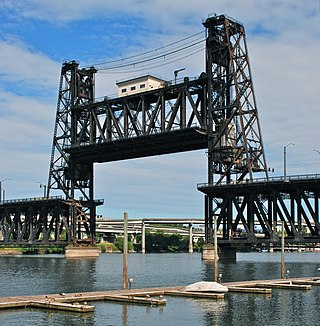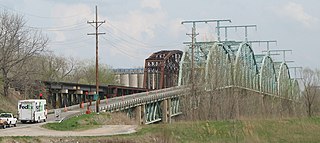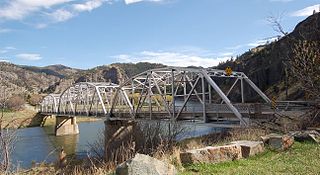
The Steel Bridge is a through truss, double-deck vertical-lift bridge across the Willamette River in Portland, Oregon, United States, opened in 1912. Its lower deck carries railroad and bicycle/pedestrian traffic, while the upper deck carries road traffic, and light rail (MAX), making the bridge one of the most multimodal in the world. It is the only double-deck bridge with independent lifts in the world and the second oldest vertical-lift bridge in North America, after the nearby Hawthorne Bridge. The bridge links the Rose Quarter and Lloyd District in the east to Old Town Chinatown neighborhood in the west.

A truss bridge is a bridge whose load-bearing superstructure is composed of a truss, a structure of connected elements, usually forming triangular units. The connected elements, typically straight, may be stressed from tension, compression, or sometimes both in response to dynamic loads. There are several types of truss bridges, including some with simple designs that were among the first bridges designed in the 19th and early 20th centuries. A truss bridge is economical to construct primarily because it uses materials efficiently.

The CSX Susquehanna River Bridge is a railroad bridge that carries CSX's Philadelphia Subdivision across the Susquehanna River between Havre de Grace and Perryville, Maryland, via Garrett Island. It was built in 1907–1910 by the Baltimore and Ohio Railroad (B&O) on the same alignment as an 1886 B&O bridge. Like its predecessor, it was the longest continuous bridge on the B&O system.

The Cincinnati Southern Bridge, originally the Cincinnati Southern Railroad Swinging Truss Bridge, is a vertical lift bridge that carries the Norfolk Southern Railway's Cincinnati, New Orleans and Texas Pacific Railway over the Ohio River between Cincinnati, Ohio, and Ludlow, Kentucky in the United States.

The Bollman Truss Railroad Bridge across the Little Patuxent River at Savage, Maryland, is one of the oldest standing iron railroad bridges in the United States and the sole surviving example of a revolutionary design in the history of American bridge engineering. The 160-foot (48.8 m) double-span was built in 1852 at an unknown location on the main line of the Baltimore and Ohio Railroad. It was moved 35 years later to its present location, where it replaced the very first Bollman bridge. Today, it carries the Savage Mill Trail.

The Ambridge–Aliquippa Bridge is a steel cantilever through truss bridge which crosses the Ohio River at Ambridge, Pennsylvania. The bridge was originally named the Ambridge-Woodlawn Bridge but was soon renamed Ambridge-Aliquippa when Woodlawn was eclipsed by the rapid expansion of the Aliquippa Works of the Jones & Laughlin Steel Company. Ambridge was incorporated in 1910 - named after the American Bridge Company which had significant operations along the Ohio River opposite the Jones & Laughlin Steel Company.

The Rulo Rail Bridge is a truss bridge across the Missouri River connecting Rulo, Nebraska, with Holt County, Missouri, and is used by the BNSF Railway to transport coal from Wyoming and Colorado to Midwest power plants.

The Willimantic Footbridge is a pedestrian bridge in the Willimantic section of Windham, Connecticut. Built in 1906, it extends from Main Street southward, across Riverside Drive, railroad tracks, and the Willimantic River, connecting downtown Willimantic to the residential area south of the river. It is one of a small number of pedestrian bridges built in the early 20th century to survive in the state. It was listed on the National Register of Historic Places in 1979.

The Liberty Bend Bridge is the common name for the two continuous truss bridges on Route 291 over the Missouri River in Sugar Creek, Missouri in the Kansas City metropolitan area. Although the bridges cross over the Missouri River, they do not cross the county line. When the Missouri River was rerouted in 1949, it cut across the northern part of Jackson County, Missouri. This left part of the county north of the river, which is known as River Bend. The original Liberty Bend Bridge was located about two miles to the north, which then crossed over into Clay County, Missouri.

The Miami Bridge, also known as the McDaniel Memorial Bridge, is a new concrete girder bridge that was built to replace a cantilever through truss bridge over the Missouri River at Miami, Missouri between Saline County, Missouri and Carroll County, Missouri. The Miami Bridge carries Route 41. The Miami Bridge was built in 1939, and its deck was replaced in 1983 as part of a rehabilitation project. The old bridge's main cantilever span was 474.7 feet, while the two anchor spans were each 415 feet in length, resulting in a total cantilever truss length of 1304.7 feet. There were 11 approach spans, including four Warren deck truss spans, three on the northern approach and one on the southern approach. All remaining approach spans were steel stringer (multi-beam/girder) spans. Total bridge length including approach spans is 2,071.9 feet. The bridge's deck width is 23.0 feet and it has vertical clearance of 16.5 feet.

The Sibley Railroad Bridge is a three-span through truss single-track railroad bridge belonging to the BNSF Railway between Jackson County, Missouri, and Ray County, Missouri, at Sibley. The bridge carries the BNSF Marceline Subdivision over the Missouri River. It is the only single-track segment of the subdivision. The original 1887–88 bridge was a three-span Whipple through truss and was later reconstructed with Parker through truss spans. Besides the freight trains of BNSF Railway, it is also used by Amtrak's Southwest Chief.

The Glasgow Bridge was five-span through truss bridge over the Missouri River on Route 240 between Howard County, Missouri and Saline County, Missouri at Glasgow, Missouri.

The Bellefontaine Bridge is a four-span truss railroad bridge over the Missouri River between St. Charles County, Missouri, and St. Louis County, Missouri. It has four 440-foot (130 m) spans. Construction started on July 4, 1892, and the bridge opened on December 27, 1893.
The Senator Roy Blunt Bridge is a twin continuous through arch truss bridge over the Missouri River at Jefferson City, Missouri, which carry U.S. Routes 54 (US 54) and 63 between Cole County and Callaway County. Before being officially named for former Missouri Senator Roy Blunt in 2022, the bridge was known as the Jefferson City Bridge.

The St. Joseph Swing Bridge is a Union Pacific Railroad truss Swing bridge connecting St. Joseph, Missouri, and Elwood, Kansas.

Lamine Township is one of 14 civil townships in Cooper County, in the U.S. state of Missouri. Twenty-two of Missouri's 114 counties, including Cooper County, have civil township governments. The other 92 counties have townships which are geographical but not governmental (civil). According to the 1860 Census, the population of Lamine Township was 830 . As of the 2020 Census, Lamine Township's population was 257.

The Pulga Bridges are two nearby bridges for highway and railroad crossings of the North Fork Feather River. The steel arch highway bridge, carrying State Route 70, crosses over the railroad bridge.

The Missouri Valley Bridge & Iron Co., also known as Missouri Valley Bridge Company, was an engineering, construction, and steel fabrication firm that operated through the late nineteenth and most of the twentieth centuries. It was based in Leavenworth, Kansas, with a WWII facility in Evansville, Indiana.

The Chamberlain Bridge, is a historic bridge connecting the towns of Chamberlain and Oacoma across the Missouri River and Lake Francis Case in Brule County, South Dakota. The bridge was originally completed in 1925 and carried U.S. Route 16 (US 16) over the Missouri River.

Hardy Bridge is a Warren through truss, three-span, two-lane bridge in the western United States. It crosses the Missouri River and is located at milepost 6 on Old U.S. Route 91, about fourteen miles (23 km) southwest of Cascade, Montana, which is southwest of Great Falls.



















